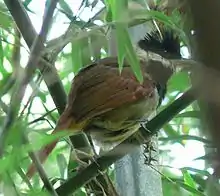White-bearded antshrike
The white-bearded antshrike (Biatas nigropectus) is a species of bird in the family Thamnophilidae, the only member of the genus Biatas. It is endemic to the Atlantic forest of Argentina and Brazil.
| White-bearded antshrike | |
|---|---|
 | |
| Scientific classification | |
| Kingdom: | Animalia |
| Phylum: | Chordata |
| Class: | Aves |
| Order: | Passeriformes |
| Family: | Thamnophilidae |
| Genus: | Biatas Cabanis & Heine, 1860 |
| Species: | B. nigropectus |
| Binomial name | |
| Biatas nigropectus (Lafresnaye, 1850) | |
The white-bearded antshrike is a bamboo specialist. It is threatened by habitat loss.
Taxonomy
The white-bearded antshrike was described by the French ornithologist Frédéric de Lafresnaye in 1850 and given the binomial name Anabates nigro-pectus.[2] The genus was erected by the German ornithologists Jean Cabanis and Ferdinand Heine in 1860 with the white-bearded antshrike as the type species.[3][4] The specific name combines the Latin words niger meaning "black" and pectus meaning "breast". The name of the genus is from the Ancient Greek biatas meaning "tyrant".[5]
Ecology
In Argentina, the white-bearded antshrike has been found only in Guadua bamboo, especially yatevo (Guadua trinii).[6] It feeds on insects that it gleans from bamboo. It is a cryptic species that rarely sings so very little is known about its ecology.[6]
Conservation
The white-bearded antshrike is globally Vulnerable.[1][7] The main threat to this species is habitat loss from clearing of bamboo.
References
- BirdLife International (2012). "Biatas nigropectus". IUCN Red List of Threatened Species. 2012. Retrieved 26 November 2013.CS1 maint: ref=harv (link)
- Lafresnaye, Frédéric de (1850). "Sur le genre Vanga, note suivie de la description du Vanga xenopirostrix et de l'Anabates nigro-pectus". Revue et Magasin de Zoologie Pure et Appliquée. Series 2 (in French). 2: 104–108 [107], plate 1 fig. 3.
- Cabanis, Jean; Heine, Ferdinand (1860). Museum Heineanum : Verzeichniss der ornithologischen Sammlung des Oberamtmann Ferdinand Heine, auf Gut St. Burchard vor Halberstadt (in German and Latin). Volume 2. Halberstadt: R. Frantz. p. 19.
- Peters, James Lee, ed. (1951). Check-list of Birds of the World. Volume 7. Cambridge, Massachusetts: Museum of Comparative Zoology. p. 162.
- Jobling, James A. (2010). The Helm Dictionary of Scientific Bird Names. London: Christopher Helm. pp. 71, 272. ISBN 978-1-4081-2501-4.
- Bodrati, A.; Cockle, K. (2006). "Habitat, distribution, and conservation of Atlantic forest birds in Argentina: Notes on nine rare or threatened species" (PDF). Ornitologia Neotropical. 17 (2): 243–258.
- BirdLife International. 2004. BirdLife Species Factsheet.
